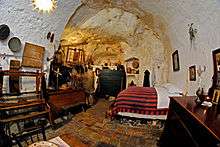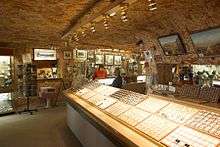Underground living


Underground living refers simply to living below the ground's surface, whether in naturally occurring caves or in built structures.
Underground dwellings are an alternative to traditionally built above-ground dwellings for some home seekers, especially those who are looking to minimize their negative impact on the environment. Some of the advantages of underground houses include resistance to severe weather, quiet living space, an unobtrusive presence in the surrounding landscape, and a nearly constant interior temperature due to the natural insulating properties of the surrounding earth. The greatest appeal for most is the energy efficiency and environmental friendliness of underground dwellings. When combined with renewable energy sources, energy cost can be greatly reduced. Initial building costs are often low, as underground building is largely subtractive rather than additive, and because the natural materials displaced by the construction can be recycled as building materials. However, underground living does have certain disadvantages; such as the potential for flooding, which in some cases may require special pumping systems to be installed.
Underground living has been a feature of fiction, such as the hobbit holes of the Shire as described in the stories of J. R. R. Tolkien and The Underground City by Jules Verne. It is also the preferred mode of housing to communities in such extreme environments as Italy's Sassi di Matera, Australia's Coober Pedy, Berber caves as those in Matmâta, Tunisia, and even Amundsen–Scott South Pole Station. Underground living is even being considered for the design of a future base on Mars. With today's technologies one can direct natural light into living spaces with light tubes.[1] Factories and office buildings can benefit from underground facilities for many of the same reasons as underground dwellings such as noise abatement, energy use, security, and community aesthetics.
Often, underground living structures are not entirely underground, typically they can be exposed on one side when built into a hill. This exposure can significantly improve interior lighting, although at the expense of greater exposure to the elements.
History
There is only written documentation of Scythian and German subterranean dwellings. Remnants have been found in Switzerland, Meklenburg and southern Bavaria: "They had a round shape with a kettle-like widening at the bottom, from eleven to fifteen metres in diameter, and from two to four metres in depth".[2]
Construction methods
In parts of rural Australia, subterranean houses are built in a manner similar to prairie dog holes. There is a "chimney" placed higher than ground-level and a lower, ground-level, entrance. This orientation causes a continuous breeze throughout the house, reducing or eliminating the need for air conditioning.
Structures
There are various ways to develop structures for underground living.
- Caves (Natural) have been used for millennia as shelter.
- Caves (Constructed)/Dugouts are a common structure for underground living. Although the tunnelling techniques required to make them have been well developed by the mining industry, they can be considerably more costly and dangerous to make than some of the alternatives. On the plus side, they can be quite deep. Some examples would be the Sassi di Matera in Italy, declared by UNESCO a World Heritage Site, and the town of Coober Pedy in Australia, built underground to avoid the blistering heat of the Outback. One of the traditional house types in China is the Yaodong, a cave house. Also, see the Nok and Mamproug Cave Dwellings in Togo, Africa.
- Earth berm structures are essentially traditional homes that have then been buried,[3] typically leaving at least one wall exposed for lighting and ventilation. However, because they are to be buried, the structures must be made of materials capable of surviving the increased weight and moisture of being underground.
- Rammed earth structures are not truly underground, in the sense of being below grade or buried beneath a berm. Instead, they are structures made of tightly packed earth, similar to concrete but without the binding properties of cement. These structures share many properties with traditional adobe construction.
- Culvert structures are a very simple approach. Large precast concrete pipes and boxes a few metres across are assembled into the desired arrangement of rooms and hallways onsite, either atop the existing ground or below grade in excavated trenches, then buried. This approach can also be referred to as Cut and Cover.
- Urban underground living is so common that few even think of it as underground. Many shopping malls are partially or totally underground, in the sense that they are below grade. Though not as exotic as the other underground structures, those working in such urban underground structures are in fact living underground.
- Shaft structures. For example, Taisei Corporation proposed to build Alice City in Tokyo Japan. The project would incorporate a very wide and deep shaft, within which would be built levels for habitation, all looking in toward a hollow core topped with a huge skylight.
- Tunnels, including storm drains, are used by homeless people as shelter in large cities.
See also
- Dugout (shelter)
- Earth house
- Earth sheltering
- Green building
- Icelandic turf houses
- Pit-house
- Underground city
- Kiva
- Souterrain
- Underwater living
- Rock-cut architecture
- Walipini
Notes
References
- Roy, Rob (2006). Earth-Sheltered Houses: How to Build an Affordable Underground Home. New Society Publishers. ISBN 978-0-86571-521-9.
- Jochelson, Waldemar. (1906). "Past and Present Subterranean Dwellings of the Tribes of North Eastern Asia and North Western America." In Congrès International des Américanistes, XVe session tenue à Québec en 1906, Vol. 2. Quebec: International Congress of Americanists, 1906, pp. 115–128. Reprinted Nendeln, Liechtenstein: Kraus Reprint, 1968.
External links
| Wikimedia Commons has media related to Underground buildings. |
- Mars Foundation
- Bag End 2 - 21st Century Hobbit Hole
- Alice City, Japan
- University of Minnesota Underground Space Center
- The $50 and up underground house book home
- Modern cave construction in Spain
- Stockton Underground : An Owner-Builder Project
- Baldassare Forestiere
- Subterranea Britannica, a society devoted the study and investigation of man-made and man-used underground places.
- Underground home built from "The $50 and Up Underground House" Book. Book Author, Mike Oehler
- Underground houses - Pictures of some of the weirdest homes built under the ground.